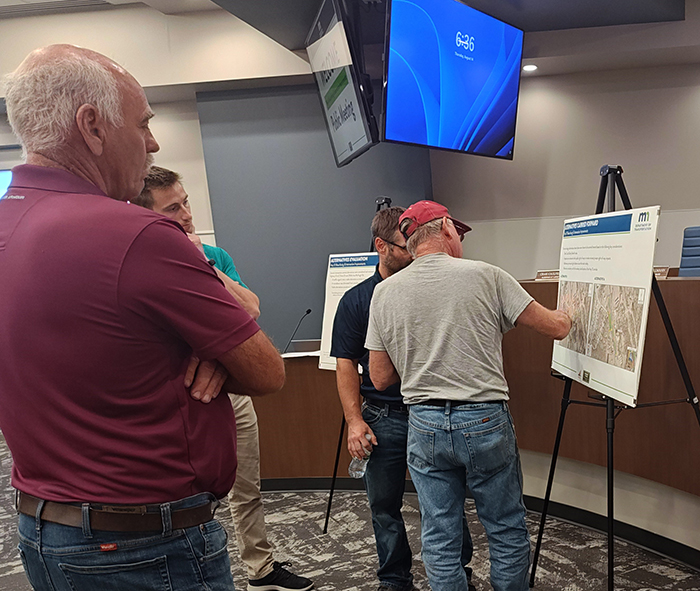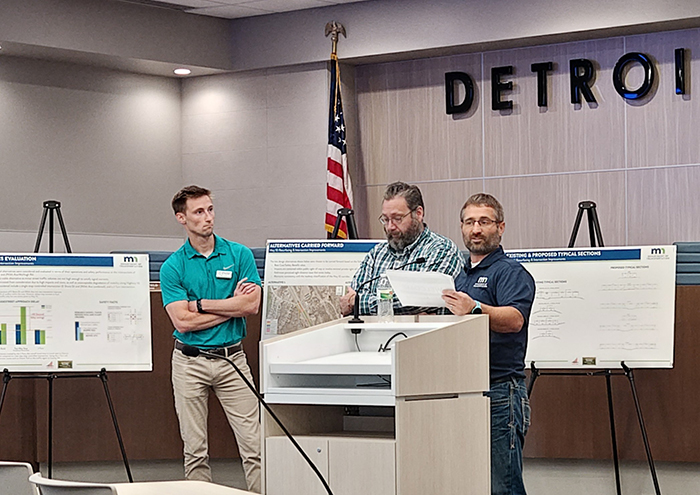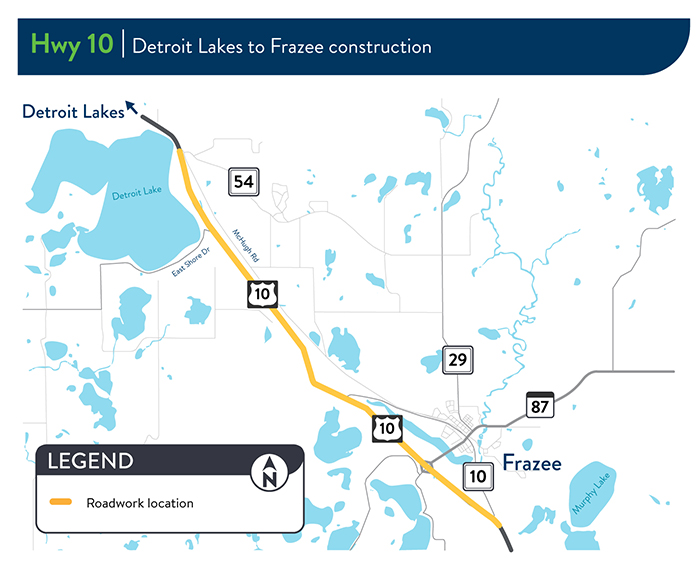Frazee exits to remain the same in 2029 Hwy 10 project
News | Published on August 19, 2025 at 1:47pm EDT | Author: frazeevergas
0
Members of the public examine the final two options of 16 offered for the McHugh, East Shore Drive intersections with MnDOT Project Manager Joeb Oyster Thursday, Aug. 14, at Detroit Lakes City Hall.
By Robert Williams
Editor
Both County Road 10 Frazee exits in Otter Tail County and Becker County will see no changes in the coming U.S. Highway 10 resurfacing project scheduled for the summer of 2029.
When asked about both County Road 10 exits and the turn to Eagle Lake Road off the westbound exit officials confirmed there would be no change to either area.

The estimated $11.9 million project will resurface (mill and overlay) Highway 10 from County Road 54 on the eastern edge of Detroit Lakes to County Road 10 east of Frazee, according to Minnesota Department of Transportation (MnDOT) Project Manager Joeb Oyster.
Oyster was joined by Bolton & Menk Engineers Chris Dahl and Mike Larson at Detroit Lakes City Hall on Thursday, Aug. 14 to discuss the project.
That discussion was focused on two proposed J-turns at East Shore Drive and McHugh Road. J-turns are a driving movement proven to reduce serious and fatal crashes caused by “T-bone” crashes at intersections. When using J-turns, drivers focus on one direction of traffic at a time. There are currently more than 100 J-turns in Minnesota.
Data collection and project analysis began in 2024.
“We want it to be safer for the public to travel on and support the surrounding areas, whether it’s economic growth or people getting from point A to B. Ultimately, on these intersections it’s public safety—trying to make them as safe as they can.

Dahl and Larson were brought in by MnDot specifically to analyze the McHugh, East Shore intersection.
The consultants created 16 different alternatives for the area to try to find the best solution for the challenges in the intersection, according to Dahl.
The nearest J-turn is located between Frazee and Perham at Highway 10 and County Road 60 (formerly 228) that was constructed in 2024.
Traffic Engineer Mike Larson noted there have been two fatal or serious injury crashes at McHugh-East Shore Drive and Highway 10 in the past few years.
“We see a lot of angle or T-bone crashes here,” he said. “That’s the main driver in how we can make this intersection more safe.”
Access points and potential accident points are what make the intersection dangerous. There are two intersections with public roads, driveways to businesses and private residences in a very, tight area.
“It makes this segment of roadway really complex; there are a lot of decisions drivers have to make when they are trying to turn onto or across the highway,” said Larson.
There are also siteline challenges seeing over the hill looking north while making a turn.
“A lot of things going against drivers and prohibiting making safe decisions when trying to access the highway,” Larson said.
A secondary issue is the delay it can take to get on the highway, especially during peak periods of the summer.
A traffic signal was not viable due to not meeting the threshold of how much traffic volume was on the side streets. A roundabout was also screened out due to not fitting in the area.
“Roundabouts are large, expensive intersection improvements that don’t really fit the character of Highway 10, at least in this more rural area of town; we want to do everything we can to maintain that regional mobility along the highway and get people across the region as fast as possible. Slowing people down with a roundabout isn’t quite necessary in this case.”
The two options settled upon were combining the two intersections created by McHugh and East Shore Drive into one intersection or a J-turn.
The analysis found that combining the intersections created more traffic trying to access Highway 10 on one intersection rather than two increasing delays.
“With the J-turn, because of the nature of how it works, everyone has to take a right turn; it’s easier to take a right than a left,” Larson said. “You’re not going to be stuck behind someone trying to make a left turn.”
MnDOT, Burlingtown Township and the City of Detroit Lakes have met monthly to discuss the project over the past year. The 16 alternatives were cut down to six and now two.
According to the traffic operations report, the two options provide the best cost/safety benefit of all 16. They also minimize the impact to private property and address the deficiencies of the current configuration and address the needs of the corridor, according to Dahl.
The statistic with the biggest influence was the reduction of conflict points in the area from 96 in the current format. A conflict point is anytime a vehicle can encounter another. The first alternative, a partial J-turn, reduces that number to 11. The first alternative was also the most affordable of the 16 options with the least amount of impact on the environment.
The second alternative is a full J-turn reduces the conflict points down to 12 and has additional safety benefits over alternative one because it is a full J-turn and the second lowest cost, according to Dahl’s report.
Neither of the J-turn designs are exactly like the County Road 60 construction near Perham as neither allows a left turn. The first alternative has a direct left turn option but traffic volumes were not at levels to substantiate it.
Bidding for the project is slated for January of 2029 with construction commencing in May or June with hopes to be done in one year.
The two preferred options will be discussed for a final decision. Public input can still be given at the MnDOT project site: www.dot.state.mn.us/d4/projects/hwy10dl-frazee/
Benefits of J-turns
• Eliminates or reduces the highest risk movements – directly crossing multiple lanes of traffic and left turns
• Shown to reduce fatalities by 70%
• Shown to reduce injuries by 42%
• Designed to help prevent severe broadside or “T-bone” crashes
• Moves traffic safely and effectively
• Simplifies navigation and traffic flow
• Can be designed and built quickly to address fatal crashes
• Maintains access to local roads and businesses

